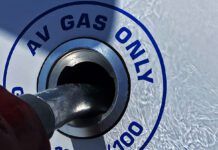Electra.aero rolled out its hybrid-electric short takeoff and landing (eSTOL) technology demonstrator for the first time this week. Called the Model EL-2 “Goldfinch,” the two-seat test vehicle will be used to “track performance and inform the design” for the company’s nine-passenger production aircraft concept. As previously reported by AVweb, Electra completed a fully integrated ground test of its hybrid-electric propulsion system in September 2022.
“In the three years since we founded Electra, we’ve designed our eSTOL aircraft, validated our blown lift technology with a sub-scale demonstrator, and run a fully integrated test of our 150-kilowatt hybrid-electric generator at full scale,’’ said Electra.aero founder and CEO John Langford. “Now we’re ready to test the entire system with this technology demonstrator aircraft.”
Electra is planning to fly a full-scale prototype of its nine-passenger design in 2025 with the goal of achieving FAA Part 23 certification in 2028. The company is targeting a 400-NM range, 175-knot cruise speed and payload of 2,500 pounds for the model. According to Electra, the design uses distributed electric propulsion and the company’s proprietary blown lift technology with “eight motors to provide additional wing lift, and hybrid-electric power that provides internal recharging capabilities for aircraft batteries.”


































hybrid-electric? So complicated, gas powered and expensive?
Despite the apparent ugliness of the prototype, this thing may not be completely crazy. I think the point is to get great STOL performance and be able to operate out of locations that don’t currently make sense for commercial passenger carrying aircraft. They (optimistically?) claim only 300 feet of runway for 9 passengers and that they get good STOL performance by having a lot of small electric motors spread all across the wing creating laminar flow across the wing at very low speeds (similar to the recent CubCrafters ducted fan leading edge slats?). Seems like that would be much more challenging with other types of motors. The downside is the weight of the generator and the efficiency loss in the conversion of gas to electric.
The concept of “hybrid” in an airplane means weight, complexity, cost, and interesting maintenance. That’s the ugly part.
That flow may remain attached, but I don’t think it will be laminar. But, with you on all the rest of your comment!
If it looks good, it’ll fly good. THIS thing is UUUUUGLY !!
Or freaking COOL!
For part 135 operators…. bummer when the bill comes in for the prop overhauls at one time.
🤔
Cub crafters just pattented a similar idea: little motors on the leading edge that force air over and under the wing. Great idea! And, unlike ICE engines, electrics have a very low probability of failure.
…But you have internal combustion engines driving generators to provide electricity to drive the motors. Engineers recognize that, for every energy conversion, there are losses. You’re still burning fossil fuel to drive devices which required fossil fuels to build, and adding more failure points to the system. What could go wrong?
I’m a big fan of electrics, but I understand that there are still many hurdles to overcome, and I get tired of flimsy “reasons” why electrics are “better”.
All true. And yet…
The fossil engine can run at one speed, maximizing its efficiency, which is a non-trivial offset to the efficiency losses. Still, they’re there. Of course, if you wanted to have STOL with fossil engines, you could put a bunch of them out along the wing… but we all know that’s a non-starter (ouch). Relative to doing that, doing this is vastly more reliable and probably much more economically viable. So, they’re giving it a shot, to see how it works out.
WHY???
Sorta’ like blown flaps – better STOL performance.
During the late 70’s at Edwards AFB, USAF tested two each prototype Boeing YC-14 (2 engine/blown flaps) / McDonnel Douglas YC-15 (4 engine normal) against each other. Ultimately, they chose neither albeit LATER, they bought the C-17 Globemaster III which was an updated larger version of the YC-15. They decided all that blown lift stuff wasn’t worth dealing with:
avgeekery.com/boeing-yc-14-design-advanced-good/
I suppose if you’re into the Valdez or New Zealand competitions, are delivering drugs or are Mike Patey, you’d be interested in such an airplane. Normal people ain’t gonna pay the extra cost or deal with the complexity.
The “hybrid” part is what makes this worthwhile bothering with.
Full Electric isn’t anywhere near ready yet – despite what all those startup companies and tech addicts claim. Hybrid at the moment is the first logical step and so this is a program that may have a chance of success long term – as it acknowledges reality rather than ignoring it.
Add to that that the company clearly positions this as a research vessel, and we’re seeing a level of “anti-hype” that has yet not been seen in the electric aviation theatre. IF we ever get to real practical aviation, it will be through efforts like this.
I’m not a fan of this stuff, but I’ve complained enough about all the hype mongering “We’ve changed the world; give us money” guys that I had to acknowledge the positive here.